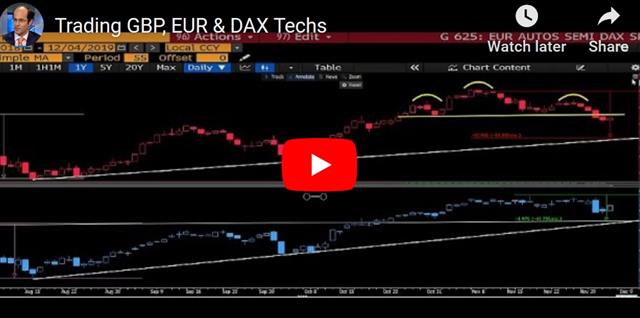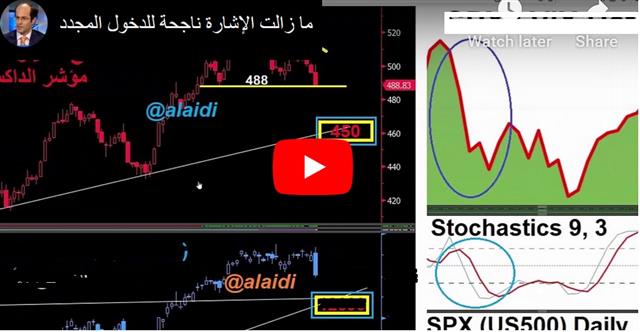Intraday Market Thoughts Archives
Displaying results for week of Dec 01, 2019Reality Check Pre Jobs
As we turn to the November jobs reports from the US and Canada (more below), here are some considerations. There are three (simplified) phases to an economic turn: Phase 1 is deterioration--As the economy softens, there's no telling where it will stop and fear takes hold; Phase 2 is flattening-- This emerges alongside policy action, such as a rate cut and stabilizing econ data. Phase 3 is improvement. Which phase are we in? Below are charts on 2 of our existing Premium trades. A new Premium trade was issued yesterday evening.
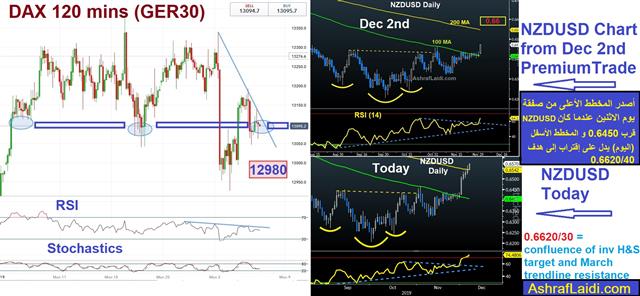
We're clearly Phase 2, but today's markets attempt to front-run everything, while pushing the narrative about a stronger 2020 economy. The data isn't there yet. Aside from some Chinese fogures– usually unreliable – there isn't global turn. Manufacturing remains especially weak and just today German factory orders were down 0.4% in October and down 5.5% year-over-year. Even in the US, this week's ADP and ISM data was all on the soft side.
Most central banks have bought into the idea of a turn and now the looming threat for 2020 is that global growth remains sluggish. Even if data begins to tick higher on better consumer spending there needs to be business investment to generate any lasting uptick. The hope is that a US-China trade deal will spark some fresh investment but that's probably unrealistic. A a phase one deal isn't going to remove the uncertainty, especially with a US election looming.
What's needed is more-aggressive stimulus from China to follow a phase one deal. In the Chinese press Friday there was more talk of an MLF cut, which would likely be combined with a loan prime rate cut and that's the key lever the PBOC is using now. Better would be a package of rate cuts, easing lending restrictions and fiscal stimulus. Something along those lines from Europe would be helpful as well.
But is it realistic?
That will be something to ponder in the weeks ahead. In the day ahead, the Canadian and US jobs reports are due. US non-farm payrolls are forecast at +183K but the risks are to the downside after ADP. Still, a miss will probably be brushed aside due to skews from the GM strike.The more-tradeable data could be from Canada where the consensus is +10K (as always). We wrote recently about a wide divergence between the employment survey and the lagging payroll survey. There are more than 100K 'extra' jobs in the employment survey and the risk is some of them disappear on Friday.
Kushner a Tell?
It's impossible to separate fact from fiction with all the noise in the China-US trade talks, but a report this week was notable for an intriguing detail. CAD and GBP are leading the gainers for the 2nd consecutive day, while NZD powered ahead after the RBNZ confirmed rates would remain on hold. The two-day OPEC meeting gets underway today. US jobless claims and durable orders are due next. Below is the chart highlighting the improving correlation between EURUSD and the Eurozone-US spread of their respective economic suprises, using Citi econ suprise index.
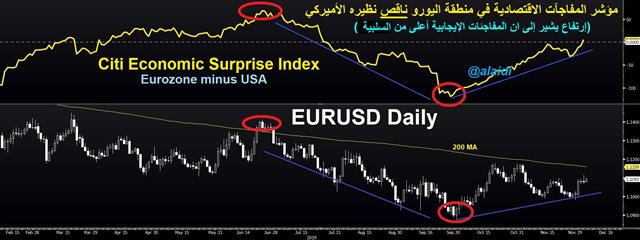
The ebb and flow of US-China trade talks is relentless but fruitless. Early in the week there was skepticism but it turned on Wednesday on a sources report saying there was progress. But a report from earlier in the week was notable for a fresh detail. It said that Trump son-in-law Jared Kushner had gotten involved the US-China trade talks.
Normally that would be a meaningless detail but Kushner got involved late in NAFTA talks when it looked like they could go off the rails. He eventually brokered a deal where Canada would give up some dairy market access in exchange for maintaining trilateral dispute resolution panels.
"I've said before, and I'll say again, this agreement would not have happened if it wasn't for Jared," US negotiator Lighthizer said after the deal was announced.
Kushner is one of the few people Trump trusts and is said to act as an interpreter for what Trump is willing to accept in a final deal. We cannot say with any confidence that this is a genuine sign we're in the final stages, but it's worth considering. At the same time, we fear that even if there is a deal it will be superficial at best with the risk of a sell-the-fact reaction.
In more-concrete news, the Bank of Canada followed in the RBA's footsteps with an upbeat take on growth and the global economy. That sent USD/CAD a full cent lower.
In the UK, the bleeding has stopped for Conservatives in the polls as they stabilize with roughly a 10 point lead, something that would mean a comfortable majority. That news and the breakout of a bull flag on the chart, led to a +100 pip rally in cable.
Looking ahead, the two-day OPEC meeting gets underway in Vienna today. The leaks and reports have already been too many to count. Talk has ranged from Russia balking at any commitments to a deeper cut. The baseline is for a 3-6 month extension of current quotas but expect it to be accompanied by fresh commitments to meeting the current quota from the countries that are over-producing. The technicals will tell the story and it will take a clean break above recent ranges in WTI and Brent to leave a lasting impression.
| Act | Exp | Prev | GMT |
|---|---|---|---|
| Challenger Job Cuts (y/y) | |||
| -33.5% | Dec 05 12:30 | ||
GBP Breaks out, USD Hurt
Broadening USD selloff after the US ADP survey on pvt sector payrolls posted its 2nd biggest decline in 3 years, falling to 67K from 121K vs an expected 135K. Broad GBP strength exploited USD selling to hit the 1.31 for the 1st time in 7 months. The latest swings in economic data highlight the opacity in the global economy in the second half of 2019. As USDX breaks below its 100 DMA, Aussie slides after GDP. The BOC decision and ISM non-manufacturing are due up next (see more below.) The English Premium video is posted below, recoding during the release of the ADP, focusing on the latest FX and index trades.
A clear narrative has developed in markets: Global economies were slipping in Q2 but the Fed and other central banks halted the decline with rate cuts. In addition, hopes for a US-China trade truce have set the stage for a pickup in global growth in early 2020.
What undermines the narrative is how spotty the data is on all of it. It's clear there was a slowdown that accelerated in Q2 but it's overwhelmingly a manufacturing slump in the global context. It makes sense that it's tied to the trade war but China has also kept policy relatively tight over the past two years and made efforts to curb excess capacity.
In China and the US household spending and other parts of the economy have held up. On Wednesday, China's November Caixin services PMI rose to 53.5 from 51.1. Unlike manufacturing, it never fell below 50.
At about the same time, Australia reported that Q3 GDP was up 0.4% q/q. That was softer than +0.5% expected but Q2 was revised a tick higher so it essentially netted out. Within the data trade was robust and added 0.2 pp which is not what you would expect in a global industrial slowdown. At the same time, household spending slowed and that was a probably related to the murky housing picture.
Ultimately, we're stuck with the incomplete picture and trying to sort out what's sentiment-driven and what's real. It's natural for businesses to pullback with all the trade war headlines but ultimately if growth and demand holds up, they will put money to work. Markets are also still struggling to adapt to a world where bonds yield nothing – a factor that skews every signal.
In the short-term we will continue to focus on incoming economic data along with trade headlines but stepping back and taking a broad survey is a reminder of how much of the current market narrative is built on flimsy data.
Up next is the Bank of Canada decision and ISM non-manufacturing reports. USD bulls need services ISM to come in within expecations of 54-54.7 after today's poor ADP print and Monday's release of manuf ISM showing a deepening contraction in that sector. Look for the BOC to take a page out of the RBA's book by retaining a dovish bias while promising nothing.
| Act | Exp | Prev | GMT |
|---|---|---|---|
| ADP Employment Change | |||
| 67K | 137K | 121K | Dec 04 13:15 |
| GDP (q/q) | |||
| 0.4% | 0.5% | 0.6% | Dec 04 0:30 |
| Final Services PMI [F] | |||
| 51.6 | 51.6 | Dec 04 14:45 | |
| PMI | |||
| 53.5 | 51.2 | 51.1 | Dec 04 1:45 |
Time for the Pre-Santa Selloff
Equity indices extend Monday's selloff after pres Trump widened his verbal tariff attacks on France and weighed the possibility of delaying a China deal til after the US elections. AUD is the strongest of the day after the RBA left rates unchanged and headed to a long holiday break with an opportunity to wait and see vis-a-vis the trade war. GBP hit $1.30, now up 1.9% on the year as the 2nd best performing currency behind CAD, which is up 2.4% vs USD. USDJPY extended its downfall, after failing a major quadruple confluence. (more below). CFTC positioning highlights the large net-negative position in NZD. A 2nd Premium trade has been issued earlier today after 2 key indicators used in the Premium Insights maintained their functionality during last week's run-up.
فيديو المشتركين و التفسير وراء آخر الصفقات
The RBA retained a dovish bias in its statement but took out any urgency in regards to easing while holding its key rate at 0.75%. Two parts of the statement helped to lift the Australian dollar. The first was a nod to falling risks in the global economy due to an improvement in trade talks. That's a variable factor and could change in a big way by the time of the next RBA decision on Feb 4. The other notable change was the addition to the final paragraph of a nod towards the lagged effects of prior easing. That's a hint that policymakers would rather be on the sidelines and may view the 55% implied odds of a Feb hike (and 85% through March) as too high.
AUD/USD rose a quarter cent after the decision but the bigger move in FX came earlier in the day as the US dollar slumped across the board. That came after a surprisingly soft ISM manufacturing index at 48.1 compared to 49.2 expected.
Another High Profile Failure
Ashraf pointed out to USDJPY's recurring failure at 110. The pair dropped back below its 200-DMA, eyeing 108.40 after another high profile failed attempt to break/reach 110, coinciding with the 55WMA, 100WMA, 200WMA, and Oct 2018 trendline resistance. VIX jumps above its 100 and 200 DMAs after posting yesterday its biggest daiky % gain in 4 months. SPX is at risk of breaking the next crucial support of 3075/76. Here is a chart below that Ashraf posted yesterday after that manuf ISM miss.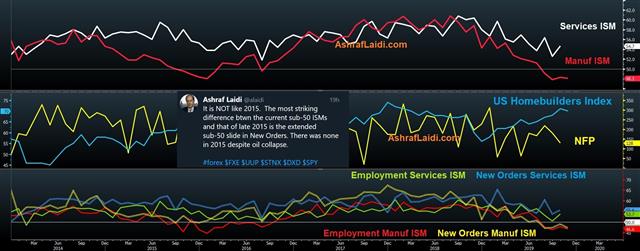
Trump took to twitter to blame the Fed and a strong dollar but manufacturing malaise is global and remains the major trouble spot. Lately there have been signs of an upturn or at least stabilization but this number is a dent in that theory.
CFTC Commitments of Traders
Speculative net futures trader positions as of the close on Tuesday. Net short denoted by - long by +.EUR -61K vs -63K prior GBP -37K vs -32K prior JPY -40K vs -35K prior CHF -21K vs -16K prior CAD +20K vs +29K prior AUD -45K vs -47K prior NZD -36K vs -35K prior
The data was delayed because of the US holiday and the surprise is the persistently large short in NZD. The turn in the kiwi continued on Monday and even with the round of risk aversion to start the week, NZD surged. That should have the shorts sweating.
USD Pauses, Key Levels Pre ISM
USD losing steam across the board as markets await US manufacturing ISM, but three items occurring at the same time ahead of the US trading session: 1. Rallying non-energy commodity currencies are led by the Kiwi after China's manufacturing PMI rose unexpectedly into expansion for the 1st time in seven months; 2. US crude oil bounces after posting the biggest daily drop in 2.5 mths; 3. US futures head back into the red partly on Trump's reinstating tariffs on Brazilian and Argentinean steel. NZDJPY was stopped out after China's data. A new FX trade has been issued, supported by 4 charts as agriculture commodities outperform metals and energy over the past three months.

Indices initially ignored China's insistence on the US to roll back tariffs before signing off Round 1 of the trade talks, but risk if gradually coming off as USDJPY drops to 109.51 from 109.70s. VIX is up for the 3rd straight session, DAX continues to fail around the 13300 and FTSE100 at 7430s.
Meanwhille, the divergence between the Dow Jones' industrials and transportation indices (above chart) continues as Transports are unable to regain their record highs from 15 months ago.
| Act | Exp | Prev | GMT |
|---|---|---|---|
| Final Manufacturing PMI [F] | |||
| 52.2 | 52.2 | Dec 02 14:45 | |
| ISM Manufacturing PMI | |||
| 49.2 | 48.3 | Dec 02 15:00 | |
| PMI | |||
| 51.8 | 51.5 | 51.7 | Dec 02 1:45 |




